Airframes
Benevolens Magister
In the last couple of GBs, some of the photos submitted for judging purposes have not really been suitable, being either small, out of focus, poorly lit, or not as specified in the 'Photo Requirements', or a combination of all of these.
May I remind you all that the six 'Finished' photos are the most important, as these are what are used for final judging. If the judges can't see the details and overall finish of the completed entries, then points can (and will) be lost because of this.
It's therefore worth taking a little time, and a little extra effort, to set-up and expose decent images - very easy with today's digital cameras - as these are what all your hard work is judged on.
Bright daylight is not always required to do this, and in fact can sometimes be detrimental, there being no control over natural light, and if anyone needs advice or tips, please don't hesitate to ask.
If in doubt as to what is required, then please look at the thread on 'Group Build Photo Requirements', and the 'Rules', posted elsewhere in the GB threads.
(Note that the revised and up-dated Rules will be posted soon.)
May I remind you all that the six 'Finished' photos are the most important, as these are what are used for final judging. If the judges can't see the details and overall finish of the completed entries, then points can (and will) be lost because of this.
It's therefore worth taking a little time, and a little extra effort, to set-up and expose decent images - very easy with today's digital cameras - as these are what all your hard work is judged on.
Bright daylight is not always required to do this, and in fact can sometimes be detrimental, there being no control over natural light, and if anyone needs advice or tips, please don't hesitate to ask.
If in doubt as to what is required, then please look at the thread on 'Group Build Photo Requirements', and the 'Rules', posted elsewhere in the GB threads.
(Note that the revised and up-dated Rules will be posted soon.)



